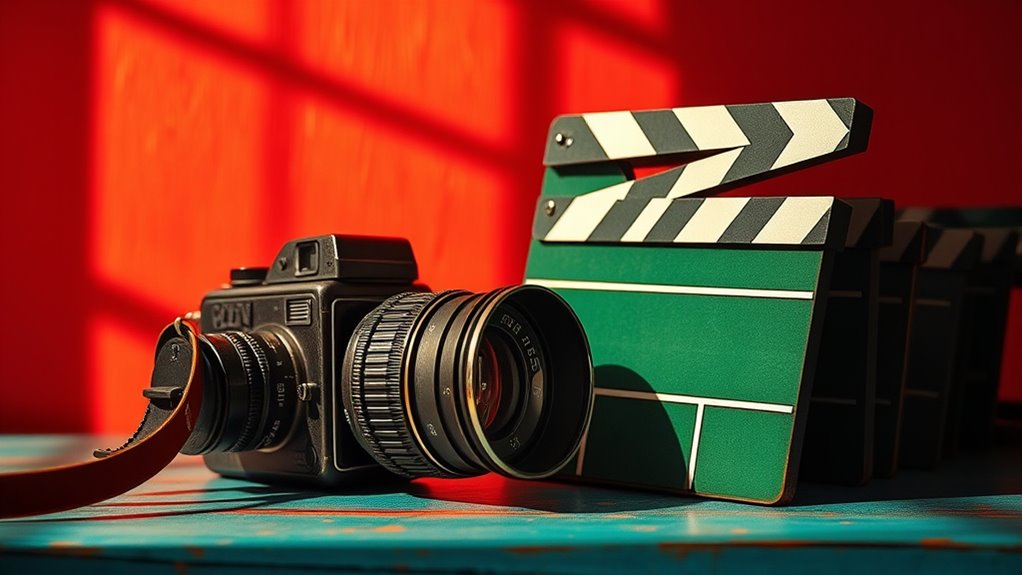To guarantee accurate colors for your movie experiences, start by calibrating your display regularly with a hardware calibrator and follow calibration software guides. Set your monitor’s color temperature to around 6500K, and use movie presets like “Cinema” mode. Adjust brightness and contrast for clarity, and avoid over-processed settings. Viewing in neutral lighting helps confirm accuracy. Keep these tips in mind to enjoy vivid, true-to-video visuals, and discover even more ways to perfect your setup.
Key Takeaways
- Use a hardware calibrator and specialized software to ensure your monitor displays accurate colors.
- Set your display’s color temperature to around 6500K and disable dynamic contrast for neutral tones.
- Select calibration profiles matching your media, such as Rec. 709 or DCI-P3, for consistent color fidelity.
- View in dim, neutral lighting and verify calibration with test patterns or reference images regularly.
- Recalibrate your monitor every few months to prevent color drift and maintain optimal accuracy.

Achieving accurate colors in your photos and digital work can substantially improve the quality of your results. When you’re watching movies, especially those with rich visuals and vibrant color palettes, having your display properly calibrated makes a noticeable difference. It ensures that what you see on screen matches the director’s intent and maintains consistency across different viewing sessions. To do this effectively, you need to understand calibration techniques and how to optimize display settings. Calibration techniques are the foundation of accurate color reproduction. They involve using tools like hardware calibrators—small devices that attach to your monitor and measure its color output. These devices work with specialized software that guides you through the calibration process, adjusting your display’s color, gamma, and brightness to standards like Rec. 709 or DCI-P3, which are commonly used for movies. By regularly calibrating your display, you prevent color drift caused by aging screens or environmental factors. This ensures consistent, accurate colors whether you’re watching a new release or revisiting classic films with vivid cinematography. Additionally, understanding color spaces and their roles in digital color management can help you select the appropriate calibration profile for your display, ensuring the best possible color fidelity. Adjusting your display settings is equally important. First, set your monitor’s brightness and contrast to comfortable levels that don’t wash out details or cause eye strain. Many displays have preset modes such as “Cinema” or “Movie,” which are designed to enhance color accuracy for film viewing. If your monitor allows, manually tweak the color temperature to a warmer setting—around 6500K is typically ideal. This setting gives you a more natural, film-like color tone, avoiding overly cool or blueish hues. You should also disable any dynamic contrast or overly aggressive sharpening features, as these can distort color fidelity. Instead, focus on maintaining a neutral, accurate baseline. Once you’ve fine-tuned your display settings, it’s wise to use test patterns or reference images to verify your adjustments. This can help you spot any discrepancies and make further refinements. Keep in mind that ambient lighting influences how colors appear; viewing in dim, neutral lighting conditions helps you better judge the true colors on your screen. Additionally, consider calibrating your display periodically—every few months—to account for any changes over time.
Frequently Asked Questions
How Does Room Lighting Affect Color Accuracy in Viewing?
Room lighting markedly impacts your color perception when viewing movies. Bright ambient light can wash out colors, making scenes appear less vibrant and accurate. To improve color accuracy, keep ambient lighting low or indirect, avoiding direct light on the screen. This way, your eyes can better perceive true colors, enhancing your overall viewing experience and ensuring you see movies as intended by filmmakers.
Can Streaming Services Impact Color Fidelity of Movies?
Streaming services can impact the color fidelity of movies because they often compress video data, which can reduce the color gamut and alter color grading. This compression may lead to less vibrant or accurate colors compared to original broadcasts or discs. To enjoy the best possible color accuracy, make sure your streaming device supports high-quality formats like HDR, and view content on a calibrated display to minimize these effects.
What Are the Best Calibration Tools for Beginners?
You should start with user-friendly calibration software like DisplayCAL or CalMAN, which guides you through color adjustments. Pair it with a beginner-friendly colorimeter such as the X-Rite i1Display or SpyderX, making calibration straightforward. These tools help you fine-tune your display for accurate colors, ensuring your movies look their best. Regular calibration with these tools keeps your screen’s color fidelity consistent, enhancing your viewing experience.
Does Screen Size Influence Perceived Color Accuracy?
Imagine a vast cinema screen pulling you into vivid worlds—that’s how screen size influences perceived color accuracy. Larger screens amplify perceived contrast and color depth, making hues seem richer or more vibrant. Conversely, smaller screens might not deliver the same intensity, potentially dulling colors. So, yes, your screen size impacts how accurately you perceive colors, with bigger screens heightening the illusion of true-to-life hues and dynamic contrast.
How Often Should I Recalibrate My Display for Optimal Color?
You should recalibrate your display every 4 to 6 weeks to maintain ideal color accuracy. Following a consistent color calibration schedule ensures your colors stay true to the source material. Incorporate regular display maintenance frequency, like cleaning your screen and checking for software updates, to support accurate color reproduction. Staying on top of these tasks helps you enjoy movies with the most precise and vibrant colors possible.
Conclusion
By following these color accuracy tips, you’ll transform your viewing experience into a vibrant journey through every hue and shade. Think of your screen as a painter’s palette—you hold the brush, and with each adjustment, you bring the masterpiece of cinema to life. Don’t settle for dull colors; instead, tune your setup and let your love for movies shine in true, stunning color. After all, perfect color accuracy makes every film feel like it’s happening right in your living room.















